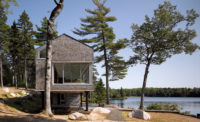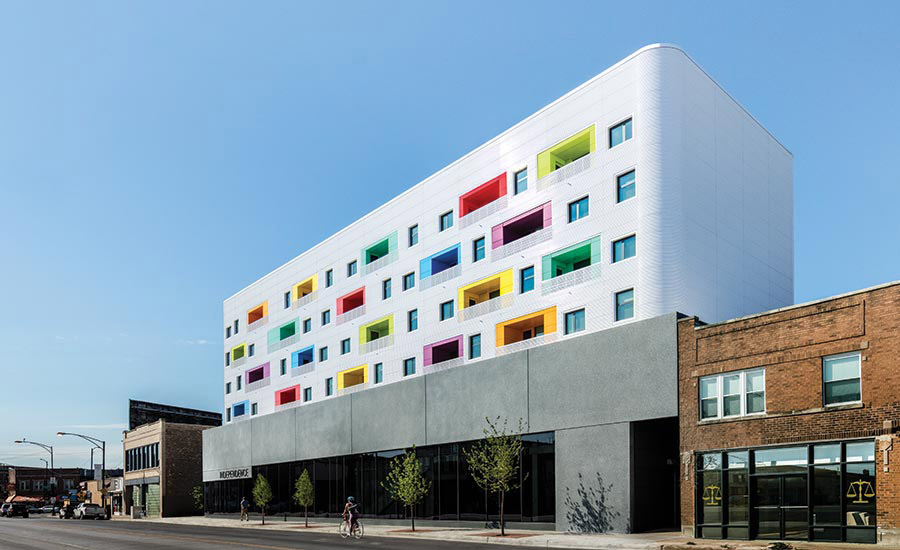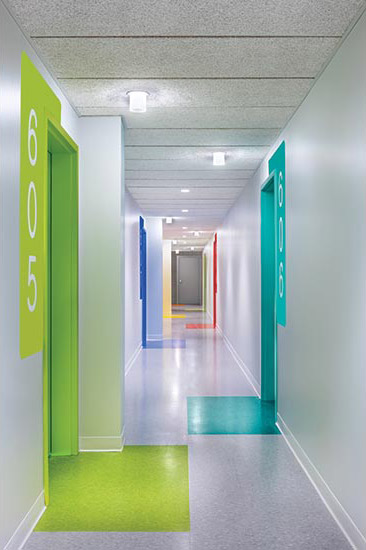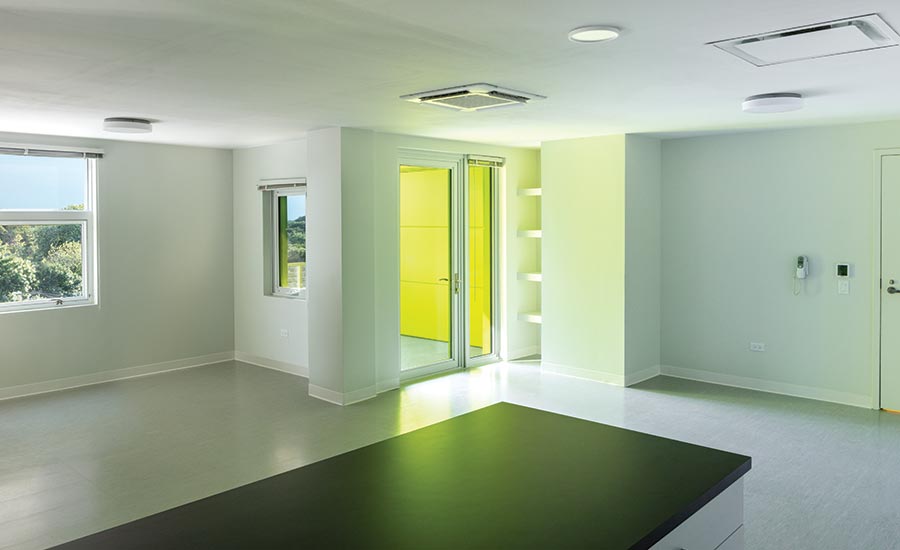Independence Library and Apartments by John Ronan Architects
Chicago

The corrugated aluminum that clads the upper levels contrasts with the dark concrete panels of the library at the base.
Photo © James Florio

The housing portion is set back from the street wall.
Photo © James Florio

The modest interiors are brightened with touches of color.
Photo © James Florio

The modest interiors are brightened with touches of color.
Photo © James Florio

Balcony railings are perforated metal.
Photo © James Florio

Balcony railings are perforated metal.
Photo © James Florio

Rubber form liner was used to make textured concrete at the elevators.
Photo © James Florio

Ronan customized the off-the-shelf bookshelves by adding frosted plexiglass.
Photo © James Florio

The radiant ceiling panels over the 29-foot-tall library conceal hydronic tubing.
Photo © James Florio

Image courtesy John Ronan Architects

Image courtesy John Ronan Architects











Architects & Firms
An old photograph of a high-rise at the Cabrini-Green housing project on Chicago’s Near North Side—the relentless monotony of its facade rendered more so in the black-and-white image—served as inspiration for architect John Ronan on what not to do when designing a building for affordable housing in the Irving Park neighborhood, seven miles farther north of those now-demolished megastructures.
Additional Content:
Jump to credits & specifications
Ronan’s building, it should be said, represents a completely different scale and approach from such notorious midcentury urban-renewal projects. Containing only 44 units, a mix of one- and two-bedrooms exclusively for seniors, the six-story structure looms large among its neighbors—mainly two-story houses, small commercial buildings, and empty lots—but addresses only a trickle of the overwhelming demand to accommodate low-income residents within our cities.

This particular model, however, incorporates senior housing with a library on the ground floor. Three such “co-location” buildings, meant to be “shared spaces that bring communities together,” according to former mayor Rahm Emanuel, emerged from a 2016 competition he initiated in conjunction with the Chicago Housing Authority and the Chicago Public Library. All three buildings—the other two by Perkins and Will and SOM—opened before Emanuel left office in May.
“We designed for speed of construction,” says Ronan, who was given just nine months between the initial concept design and groundbreaking, and 17 months to build. The structure went up fast, in part because the bottom two levels have a poured-in-place reinforced-concrete structure and the top four steel, so different trades worked simultaneously. It’s a building method Ronan successfully used before at the much larger Gary Comer Youth Center on the South Side, built in even less time. “I like these kinds of projects, actually,” admits Ronan, “they don’t drag on and on.”
At the Independence Library and Apartments, cost was obviously another concern. The shorter construction period helped with that, but combining the two programs did not. Ronan wanted each aspect of the building to have its own character. Clad in a dark ground-and-polished concrete that looks like terrazzo—its precast panels, some as large as 12½ feet by 36 feet, were installed in a day—the two-story library has a strong street presence. Glazing along most of its 160-foot sidewalk frontage allows people from the neighborhood, who had lost their library to a fire a few years before, to see the activity inside.
The housing, on the other hand, is set back 18½ feet from the street wall, its stark white corrugated metal facade punctuated with pops of color. “Back in the ’90s, when I witnessed Cabrini-Green getting torn down,” recalls Ronan, “there was a moment mid-demolition where you could see the individual units inside and all the different wallpaper. I’ll never forget that.” To differentiate the units here, Ronan designed each with a balcony of a different color. He staggered the balconies to “get away from the cookie-cutter nature of social housing,” a cost-premium that somehow survived value-engineering. The result is a playful but carefully composed facade—front and back. At the corners, Ronan employs rounded metal panels with the maximum 5-foot radius available, to further distinguish the taller structure from the boxlike library at its base.
The corrugated metal on the facade makes a transition to perforated sheets that act as railings for the balconies. It’s a simple but effective detail that elevates this cheap material. While the metal here is coated aluminum, Ronan similarly employed corrugated zinc at Chicago’s Poetry Foundation, the perforated panels there providing a veil-like screen over and around its courtyard.
Inside the housing, apartment entrances along the corridors are highlighted with a color matching its balcony, the bright shades helpful for vision-impaired seniors or guests. “It was a choice based partly on visiting my mother’s retirement home,” says Ronan, “I could never find her room.” Units are spacious but, not unexpectedly, unexceptional—apart from the generous outdoor area the balconies offer.
The 16,000-square-foot library, however, which Ronan imagines as a source of pride for the neighborhood, is a soaring space, its exposed concrete also punctuated with brightly colored furniture and finishes. 29½-foot-tall concrete columns run down its center, which is surrounded by a mezzanine level containing the adult reading area and a media room with a mural painted by local street artist Dont Fret, featuring Chicago literary figures (including, at Ronan’s request, Harriet Monroe, the founder of Poetry magazine, which grew into the Poetry Foundation). A 7,750-square-foot planted terrace, built over the parking area, extends from the mezzanine and is accessible to residents and, by appointment, to library groups. It adds to the diversity of spaces within the building, which also includes a large community room on the ground floor with its own entrance.
While the library opened in early 2019, residents for the units above moved in just this summer. Ronan has high hopes for how the colocated spaces will cohabitate, especially the mingling of residents with the throngs of children who have been filling the library. In the meantime, the structure has quickly become a landmark in an otherwise nondescript area, bringing design-minded building to Chicago’s outer neighborhoods. And though Ronan admits you can’t put a library in every social housing project, doing so here can help to “change people’s perceptions about social housing”—the need for which will only become more acute.
CreditsArchitect: John Ronan Architects
Personnel in architect's firm who should receive special credit: Design Team: John Ronan FAIA (lead designer); Marcin Szef (project architect); Andrew Akins; Sam Park AIA, Danielle Beaulieu AIA LEED GA; Eric Cheng; John Kerner; Courtney Arabea; Laura Gomez Hernandez; Will Corcoran AIA; Wenda Wei
Associate architect(s): (John Ronan Architects—Design Architect & AOR)
Interior designer: John Ronan Architects
Engineers: Structural: Thornton Tomasetti MEPFP: dbHMS Civil: Terra Engineering
Consultants: Acoustics: Shiner Acoustics
General contractor: Leopardo Companies
Photographer: James Florio; (970) 888-2126 |
SpecificationsStructural System Levels 1-2: Concrete, Levels 3-6: Steel Frame
Exterior Cladding Metal panels: Centria MetalWrap Metal/glass curtain wall: Pittco Rainscreen: Centria Econolap Precast concrete: Gate Precast EIFS, ACM, or other: Alpolic
Roofing Built-up roofing: Firestone
Windows Metal frame: Kawneer/Traco
Glazing Glass: Technoglass
Doors Entrances: C.R. Laurence, Pittco Metal doors: Kawneer/Traco, Assa Abloy
Hardware Locksets: Best (cores only) Closers: LCN Exit devices: Von Duprin Pulls: Rockwood
Interior Finishes Acoustical ceilings: Armstrong Tectum Wall coverings: Designtex Plastic laminate: Nevamar, Formica Solid surfacing: Dupont Corian Floor and wall tile: Daltile Resilient flooring: Armstrong Carpet: Bentley Mills Special interior finishes unique to this project: Armstrong Tectum
Furnishings Office furniture: KI, Demco Chairs: KI Tables: KI Upholstery: Other furniture: Library Shelving: Bradford Systems
Lighting Interior ambient lighting: ALW Downlights: Indy, USAI Lighting, Philips Lightolier Dimming system or other lighting controls: Leviton
Conveyance Elevators/escalators: Otis
Plumbing American Standard, Zurn , Elkay, Kohler, Delta
Energy Other unique products that contribute to sustainability: Radiant Ceiling and In-slab radiant: Uponor |

















